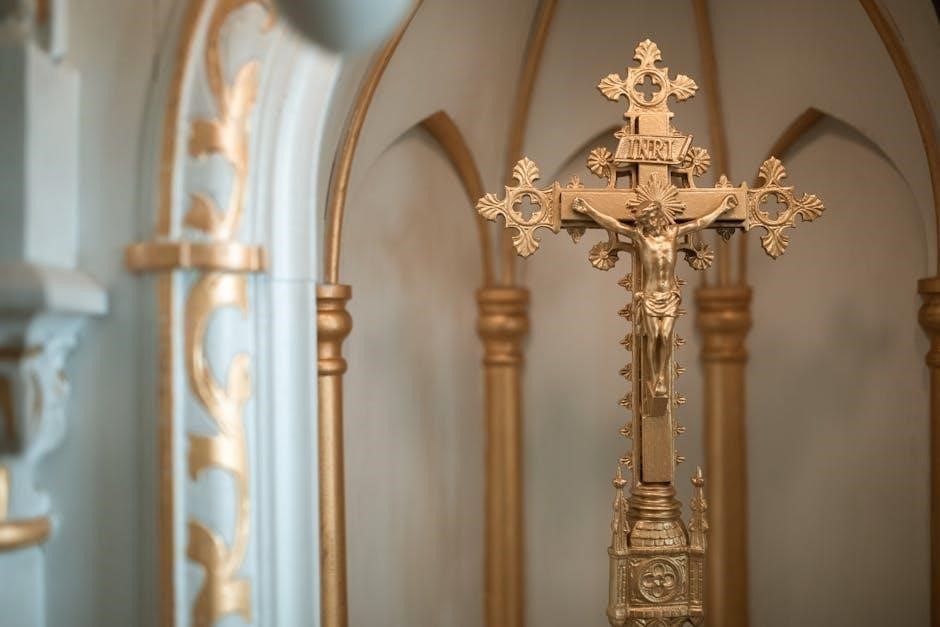The Litany of the Divine Child Jesus is a Catholic prayer offering invocations for mercy and protection. It is often recited communally, fostering devotion and spiritual growth, and is conveniently available in PDF format for easy access, inspiring deeper faith and connection with the Divine Child.
1.1 Overview of the Litany
The Litany of the Divine Child Jesus is a Catholic prayer that invokes the infant Jesus, seeking mercy and protection. It is structured for communal recitation, with a leader and congregation responding alternately. The litany includes salutations like “Jesus, hear us” and “Jesus, graciously hear us,” emphasizing themes of divine mercy and redemption. Available in PDF format, it offers a convenient and accessible way to deepen devotion to the Divine Child, fostering spiritual growth and faith. Its concise structure makes it ideal for personal or group prayer, inspiring reflection on Jesus’ childhood and divine grace.
1.2 Significance in Catholic Devotion
The Litany of the Divine Child Jesus holds profound significance in Catholic devotion as a powerful prayer invoking divine mercy and protection. It deepens faith by focusing on Jesus’ childhood, emphasizing His role as a source of grace and redemption. The litany’s structure, designed for communal recitation, fosters unity and spiritual growth among the faithful. Its availability in PDF format enhances accessibility, making it a cherished resource for personal and collective devotion, inspiring Catholics to seek refuge in the Divine Child’s boundless love and intercession.

Historical Background of the Litany
The Litany of the Divine Child Jesus traces its origins to the humble, hidden life of the Holy Child, reflecting divine mercy and boundless love.
2.1 Origins and Development
The Litany of the Divine Child Jesus originates from the humble, hidden life of the Holy Child, emphasizing divine mercy and boundless love. It reflects the mysteries of Jesus’ childhood, as noted by Cornelia Connelly, who highlighted the treasures of God’s mercy in the Infant Jesus’ life. The litany is deeply rooted in Catholic tradition, emerging as a communal prayer that invokes Jesus’ mercy and protection. Its structure includes salutations to the Divine Child, followed by petitions for grace and forgiveness, making it a powerful devotional tool. The prayer’s development is closely tied to its use in communal recitation, fostering unity and spiritual reflection among the faithful.
2.2 Influence of Catholic Tradition
The Litany of the Divine Child Jesus is deeply influenced by Catholic tradition, reflecting the Church’s veneration of the Holy Child. It incorporates traditional elements like invocations for mercy and protection, common in Catholic devotional practices. The litany’s structure, with its repetitive petitions and communal recitation, aligns with the Church’s emphasis on liturgical prayer. Its focus on the Holy Trinity and the Infant Jesus mirrors the rich theological traditions of Catholicism, making it a prayer that resonates with centuries of Catholic spirituality and devotion.

Structure of the Litany
The litany begins with salutations to the Holy Trinity, followed by invocations to the Infant Jesus, emphasizing mercy and protection, designed for communal recitation, available in PDF for easy access.
3.1 Salutations to the Divine Child
The salutations to the Divine Child in the litany are heartfelt invocations that honor the Infant Jesus, acknowledging His divine nature and role as the Son of God. These salutations are structured to express deep reverence and devotion, often beginning with “Infant Jesus, have mercy on us” and “Infant, true God, have mercy on us;” They emphasize His role as the Redeemer and the source of divine grace, inviting the faithful to reflect on His humility and love. This section sets a contemplative tone for the rest of the prayer, fostering a sense of intimacy with the Divine Child.
3.2 Invocations for Mercy and Protection
The litany includes heartfelt invocations seeking the Divine Child’s mercy and protection. These prayers petition Jesus to deliver humanity from sin and suffering, emphasizing His role as Redeemer. Phrases like “Infant Jesus, have mercy on us” and “Infant, true God, have mercy on us” are repeated, underscoring devotion. The invocations also highlight Jesus’ divine attributes, such as His poverty and sufferings, as sources of grace. This section fosters a deep sense of trust in the Divine Child’s intercession, offering comfort and hope to the faithful seeking spiritual deliverance and protection.

Key Elements of the Litany
The litany emphasizes themes of mercy, redemption, and divine grace. It highlights the Holy Trinity’s role and includes invocations for protection, reflecting the Divine Child’s transformative power.
4.1 Themes of Mercy and Redemption
The Litany of the Divine Child Jesus profoundly emphasizes themes of mercy and redemption. It invokes the infant Jesus to deliver humanity from sin and evil, reflecting His transformative power. Through heartfelt supplications, the prayer underscores divine grace and the Holy Trinity’s role in salvation. This sacred litany serves as a powerful reminder of God’s boundless love and the hope of redemption through the Divine Child’s innocent and pure example, inspiring devotion and spiritual renewal among the faithful.
4.2 Role of the Holy Trinity
The Litany of the Divine Child Jesus highlights the Holy Trinity’s divine presence in the life of the infant Jesus; It petitions God the Father, the Son, and the Holy Spirit, acknowledging their unity and role in salvation. The prayer seeks mercy and grace through the Trinity’s intercession, emphasizing their divine plan of redemption. This focus on the Holy Trinity deepens the litany’s theological richness, connecting devotees to the Triune God’s infinite love and mercy, as revealed through the Divine Child’s life and mission.
Theological Significance
The Litany reflects divine love and mercy, emphasizing Jesus’ infancy as a symbol of God’s boundless compassion and the Holy Trinity’s role in human redemption.
5.1 Representation of Jesus’ Childhood
The Litany of the Divine Child Jesus beautifully portrays the infancy and hidden life of Jesus, emphasizing His divine love and mercy. It reflects the profound mystery of God’s incarnation, where the Almighty takes on human form, embodying humility and vulnerability. The prayer highlights key moments of Jesus’ childhood, such as His birth in Bethlehem and His dependence on Mary and Joseph, symbolizing divine love and trust. This representation invites believers to contemplate the deeper theological truths of God’s boundless compassion and the sacredness of human life.
5.2 Symbolism in the Prayer
The Litany of the Divine Child Jesus is rich in symbolism, reflecting divine love and redemption. The infant Jesus represents vulnerability and humility, while His titles, such as “Treasure of Grace” and “Fountain of Love,” highlight His divine nature. The prayer’s invocations, like “Infant Jesus, have mercy on us,” underscore His role as a source of mercy and compassion. The Holy Trinity is also symbolized, emphasizing the unity of God’s plan. These symbols deepen devotion, inviting believers to contemplate the profound mystery of God’s incarnation and boundless love.
Invocations and Supplications
The litany includes specific invocations like “Infant Jesus, have mercy on us” and “Jesus, graciously hear us”, seeking divine mercy and protection through the Holy Child’s intercession.
6.1 Specific Requests in the Litany
The litany contains heartfelt supplications, such as “Infant Jesus, have mercy on us” and “Jesus, graciously hear us”, seeking divine intervention for family unity, spiritual guidance, and protection. It also petitions for deliverance from suffering and evil, emphasizing trust in the Holy Child’s intercession. These requests reflect a deep reliance on Jesus’ mercy and grace, aligning with the prayer’s purpose of fostering devotion and spiritual renewal.
6.2 Communal Recitation Practices
The litany is traditionally recited in community settings, fostering unity and shared devotion. Participants respond with phrases like “Jesus, hear us” and “Jesus, graciously hear us”, creating a rhythmic and reflective prayer experience. Many Catholic groups, including schools and parishes, incorporate this litany into their monthly devotionals, often on the 25th of each month. Communal recitation strengthens faith and fosters a collective plea for mercy and protection, emphasizing the power of prayer in unity;
Benefits of Reciting the Litany
The Litany of the Divine Child Jesus fosters spiritual growth and deepens devotion. It invokes mercy and protection, offering inspiration for a faith-centered life.
7.1 Spiritual Growth and Devotion
Reciting the Litany of the Divine Child Jesus enhances spiritual growth by deepening one’s connection with the Infant Jesus. It inspires a life of humility, love, and prayer, fostering a profound devotion. The litany’s invocations encourage self-reflection and a commitment to living virtuously, leading to a stronger faith and a deeper sense of divine love. Regular recitation cultivates a heart open to God’s mercy and grace, enriching one’s spiritual journey and fostering a closer relationship with the Divine Child.
7.2 Intercession and Divine Mercy
The Litany of the Divine Child Jesus is a powerful tool for intercession, seeking divine mercy through the Infant Jesus’ loving gaze. It includes specific invocations like “Infant Jesus, have mercy on us,” imploring grace and protection. The litany’s structure emphasizes deliverance from evils and blessings, fostering a deep reliance on God’s mercy. Recited communally, it strengthens believers’ pleas, uniting them in prayer. This sacred practice connects faithful hearts to the Divine Child, offering a profound means to experience and share divine mercy in daily life, reflecting trust in His boundless love and grace.

Cultural Impact and Popularity
The Litany of the Divine Child Jesus has grown in popularity, especially in the United States, due to its heartfelt invocations and accessibility in PDF format.
8.1 Growth in the United States
The Litany of the Divine Child Jesus has experienced significant growth in popularity across the United States, particularly due to its heartfelt invocations and the influence of Catholic devotional practices. Its availability in PDF format has made it easily accessible, fostering widespread adoption among families, parishes, and individual devotees. This growth is further attributed to the efforts of Catholic leaders and the cultural resonance of the Divine Child’s symbolism, which continues to inspire spiritual reflection and communal prayer nationwide.
8.2 Influence of Devotional Practices
The Litany of the Divine Child Jesus has been deeply influenced by Catholic devotional practices, which emphasize prayer, reflection, and communal worship. Its structure, featuring salutations and invocations, aligns with traditional Catholic liturgical customs. The availability of the litany in PDF format has further enhanced its integration into personal and communal devotions, making it a popular choice for families and parishes seeking to deepen their spiritual connection with the Divine Child. This adaptability has fostered its widespread use in various Catholic communities, enriching prayer life and devotion.
Using the Litany in PDF Format
The Litany of the Divine Child Jesus in PDF format offers unparalleled accessibility and convenience, enabling believers to pray devotionally anytime, anywhere, while preserving its sacred traditions and inspiring spiritual reflection through its digital availability.
9.1 Accessibility and Convenience
The Litany of the Divine Child Jesus in PDF format enhances accessibility, allowing devotees to pray effortlessly on various devices. This convenient format ensures the prayer is always available, whether for personal reflection or communal recitation. The PDF preserves the prayer’s traditional structure while making it easily shareable. Its digital presence fosters widespread devotion, enabling believers to engage with the litany anytime, anywhere. This modern approach to a timeless prayer bridges tradition with contemporary needs, ensuring its reach and impact endure seamlessly in the digital age.
9.2 Digital Resources for Prayer
Digital resources for the Litany of the Divine Child Jesus, such as PDF downloads, offer believers convenient access to this sacred prayer. These resources are easily shared across devices, making communal recitation simpler. The PDF format ensures the prayer’s integrity, preserving its traditional structure while adapting to modern technology. Digital versions often include additional devotional content, such as novenas or reflections, enriching the prayer experience. This seamless integration of faith and technology supports both personal and communal spiritual practices, fostering deeper engagement with the Divine Child Jesus.
The Litany of the Divine Child Jesus PDF offers a powerful devotional tool, fostering spiritual growth and divine mercy. Its convenience and accessibility make it a cherished prayer resource.
10.1 Summary of the Litany’s Importance
The Litany of the Divine Child Jesus holds profound significance as a devotional prayer, emphasizing mercy, protection, and spiritual growth. Its structured format, with salutations and invocations, fosters a deep connection with the Divine Child. Available in PDF, it offers convenience for personal and communal recitation, making it accessible to all. This prayer not only strengthens faith but also serves as a reminder of Jesus’ infant life and the boundless love embodied in His childhood. Its enduring popularity underscores its role in nurturing devotion and intercession.
10.2 Encouragement for Devotional Use
Embracing the Litany of the Divine Child Jesus enriches spiritual life, offering a heartfelt way to connect with the Infant Jesus. Its availability in PDF makes it easy to integrate into daily prayer routines, whether individually or with others. By reciting this litany, faithful devotees can deepen their devotion, seek mercy, and experience the transformative grace of the Divine Child. It is a powerful tool for fostering a closer relationship with Jesus, inviting His blessings and guidance in everyday life.

Additional Resources
Explore related prayers like the Infant Jesus of Prague Novena and Devotional Materials. Access PDFs, novenas, and further readings on Catholic websites and prayer libraries.
11.1 Related Prayers and Novenas
Discover the Infant Jesus of Prague Novena, a traditional prayer seeking mercy and blessings. Explore other novenas and devotional materials, such as the Divine Child Jesus Chaplet, offering meditations on His childhood. These prayers complement the litany, deepening devotion and fostering spiritual growth. Available in PDF formats, they provide accessible resources for personal or communal recitation, enriching your faith journey with diverse expressions of worship and intercession to the Divine Child Jesus.
11.2 Further Reading and References
For deeper understanding, explore resources like The Litany of the Divine Child Jesus in PDF, which offers insights into its origins and significance. Historical studies on Catholic devotions highlight its role in fostering spiritual growth. Theological analyses provide context on its symbolism and connection to the Holy Trinity. Digital archives and religious websites also offer complementary materials, such as prayer guides and reflections, enhancing your exploration of this sacred devotion to the Divine Child Jesus.
